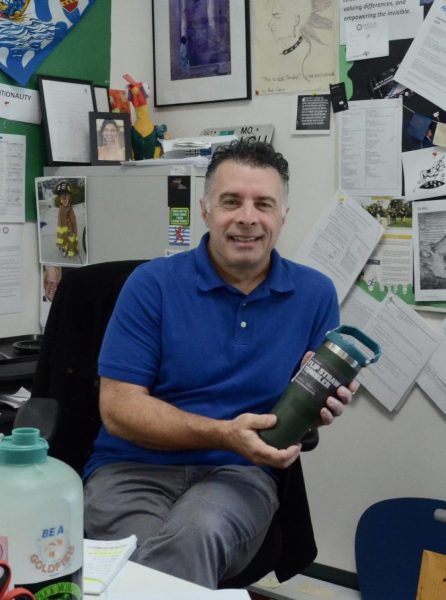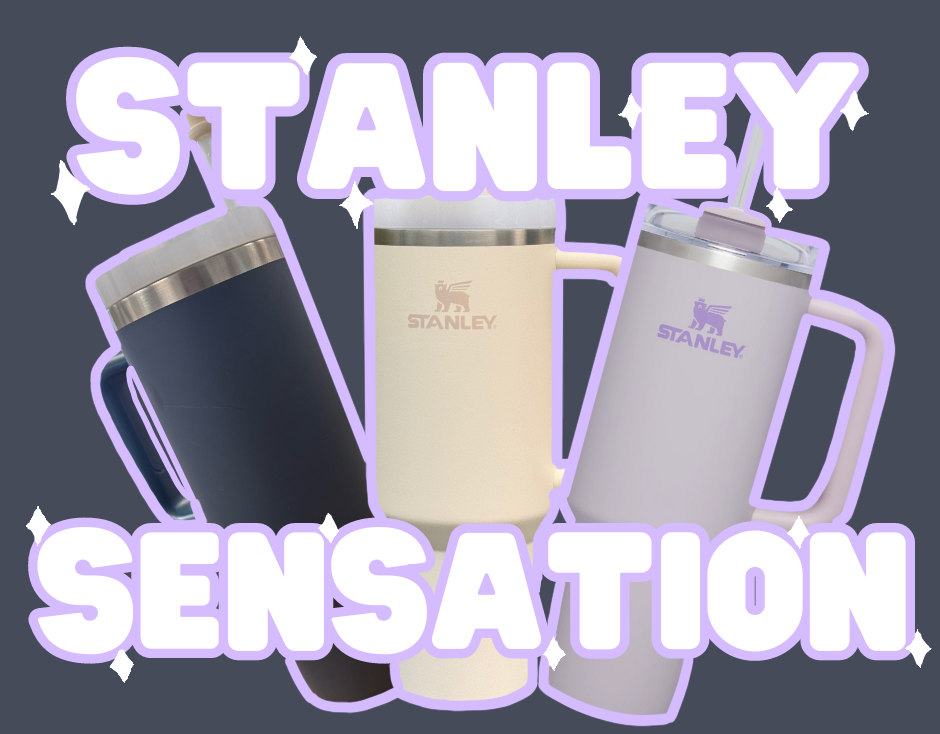Viral videos capture crowds of people instigating mobs in Target, pushing each other as they reach for a standalone rack in the center of the store. Their object of desire? A $45 limited-edition Quencher H2.0 FlowState Tumbler, also known as the Stanley Cup.
Although the Stanley brand is over a century old, Stanley’s drinkware recently exploded in popularity through social media, with the hashtag “#StanleyTumbler” amassing over 200 million views on TikTok. In these videos, influencers and celebrities like Adele and Carrie Underwood praise the Stanley Cup’s functionality: It keeps a drink cold for nine to eleven hours, has a handle and straw for easy drinking and fits in a car’s cup holder.
“I understand the recent craze because Stanleys are cute to carry around and they’re functional,” Stanley Cup user Yasmin Sudarsanam (11) said. “I don’t see too much of a difference compared to other water bottles. I had a Hydro Flask before, and honestly, they’re kind of the same. It can keep the water cold for the same amount of time, it’s pretty much the same size but a little bigger.”
How was a century-old company able to become one of the most popular drinkware brands today?

When physicist William Stanley invented the steel vacuum-sealed bottle in 1913, his company originally targeted workmen and outdoor enthusiasts as their main demographic. The Quencher was introduced in 2016 but discontinued in 2019 due to insubstantial sales. New leadership resumed production of the cup in 2020 with a broader array of colors and a new social media marketing strategy that focused on affiliate marketing, where third-party publishers are compensated for promoting the company’s products.
The company has also sold Quenchers in collaboration with Starbucks and country music star Lainey Wilson. Special-edition cups like the Valentine’s Day-themed Quencher bottle have gained immense popularity, causing the viral chaos in Target stores.
“I want a Stanley Cup because I think the design is really aesthetic and I always see people on my social media page using it,” Ashley Mo (10) said. “I can’t tell if those Target videos are exaggerated, but I think it really is a craze. The fact that people are fighting over these water bottles just shows how much social media can impact daily life.”
The Quencher’s popularity on TikTok has resulted in impressive sales. According to CNBC, Stanley was estimated to have made over $750 million in 2021, compared to $70 million in 2020.
Many buyers are also reselling Stanley products on e-commerce platforms like eBay and Poshmark. On StockX, an online marketplace and reseller, there have been more than 2,300 total trades of Stanley products, and the average resale price of a limited-edition Stanley Cup is up to $215, according to data provided by StockX.
“I think the trend started because of social media and Tik Tok, and in all those ‘day in my life’ and ‘get ready with me’ videos you see the Stanley in the background,” Yasmin said. “Then everyone else wants to get it, and then more and more stores have been stocking them, like Target and Dick’s Sporting Goods. So it’s probably a mix of social media and more stores are carrying them.”
On social media, some influencers show off extensive collections of Stanleys in various colors, and some buy accessories for their Stanley such as attachable bags and straw covers. The glorification of a seemingly simple water bottle can lead some people to ridicule those who own Stanleys.
“People who buy trendy items like Stanley Cups are sometimes made fun of for being ‘basic’,” Ashley said. “But I think these things are trendy for a reason, and you shouldn’t not buy something just because it’s popular or expensive.”

Many praise the Stanley Cup, along with other social-media-trend water bottle brands such as the Hydro Flask and Yeti, for facilitating eco-friendly hydration. Despite its theoretical environmental advantage, widespread craze for Stanleys drives ecologically harmful overconsumption, contradicting the very purpose of reusable water bottles.
Although Stanley’s website claims that Stanley Cups “never need to be thrown away or replaced,” its buy-it-for-life legacy is undermined by the sheer amount of production and consumption as a trendy collectors’ item. Some question the energy efficiency of stainless steel production compared to plastic.
“It’s in this long line of things in consumer culture when people go crazy over something whose function is essentially the same as others, but it confers exclusivity and status and therefore becomes disproportionately popular,” History Department Chair Mark Janda, who was gifted a Stanley Cup, said. “Whether it’s Cabbage Patch dolls when I was a kid, or any number of toys that become a huge fad every holiday season, the Stanley Cup just seems to fit in that mold.”
As the Stanley craze reaches monumental heights, this widespread trend reflects a broader issue within consumer culture. The immense popularity of eco-friendly products like the Stanley Cup can paradoxically lead to environmentally harmful overconsumption.




![LALC Vice President of External Affairs Raeanne Li (11) explains the International Phonetic Alphabet to attendees. "We decided to have more fun topics this year instead of just talking about the same things every year so our older members can also [enjoy],” Raeanne said.](https://harkeraquila.com/wp-content/uploads/2025/10/DSC_4627-1200x795.jpg)


















![“[Building nerf blasters] became this outlet of creativity for me that hasn't been matched by anything else. The process [of] making a build complete to your desire is such a painstakingly difficult process, but I've had to learn from [the skills needed from] soldering to proper painting. There's so many different options for everything, if you think about it, it exists. The best part is [that] if it doesn't exist, you can build it yourself," Ishaan Parate said.](https://harkeraquila.com/wp-content/uploads/2022/08/DSC_8149-900x604.jpg)




![“When I came into high school, I was ready to be a follower. But DECA was a game changer for me. It helped me overcome my fear of public speaking, and it's played such a major role in who I've become today. To be able to successfully lead a chapter of 150 students, an officer team and be one of the upperclassmen I once really admired is something I'm [really] proud of,” Anvitha Tummala ('21) said.](https://harkeraquila.com/wp-content/uploads/2021/07/Screen-Shot-2021-07-25-at-9.50.05-AM-900x594.png)







![“I think getting up in the morning and having a sense of purpose [is exciting]. I think without a certain amount of drive, life is kind of obsolete and mundane, and I think having that every single day is what makes each day unique and kind of makes life exciting,” Neymika Jain (12) said.](https://harkeraquila.com/wp-content/uploads/2017/06/Screen-Shot-2017-06-03-at-4.54.16-PM.png)








![“My slogan is ‘slow feet, don’t eat, and I’m hungry.’ You need to run fast to get where you are–you aren't going to get those championships if you aren't fast,” Angel Cervantes (12) said. “I want to do well in school on my tests and in track and win championships for my team. I live by that, [and] I can do that anywhere: in the classroom or on the field.”](https://harkeraquila.com/wp-content/uploads/2018/06/DSC5146-900x601.jpg)
![“[Volleyball has] taught me how to fall correctly, and another thing it taught is that you don’t have to be the best at something to be good at it. If you just hit the ball in a smart way, then it still scores points and you’re good at it. You could be a background player and still make a much bigger impact on the team than you would think,” Anya Gert (’20) said.](https://harkeraquila.com/wp-content/uploads/2020/06/AnnaGert_JinTuan_HoHPhotoEdited-600x900.jpeg)

![“I'm not nearly there yet, but [my confidence has] definitely been getting better since I was pretty shy and timid coming into Harker my freshman year. I know that there's a lot of people that are really confident in what they do, and I really admire them. Everyone's so driven and that has really pushed me to kind of try to find my own place in high school and be more confident,” Alyssa Huang (’20) said.](https://harkeraquila.com/wp-content/uploads/2020/06/AlyssaHuang_EmilyChen_HoHPhoto-900x749.jpeg)











